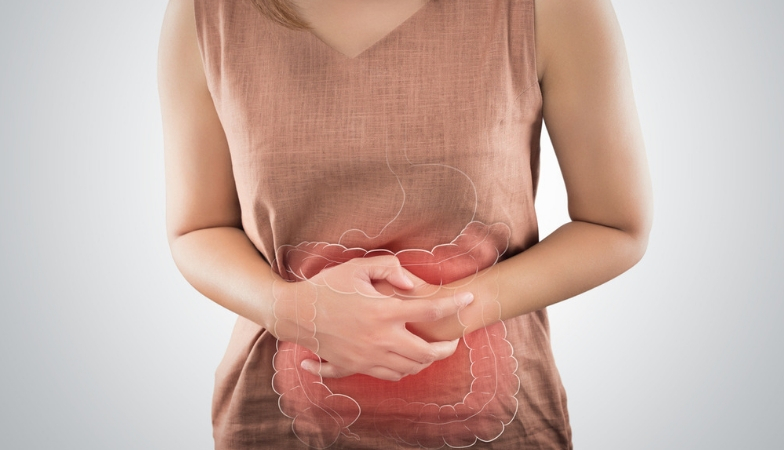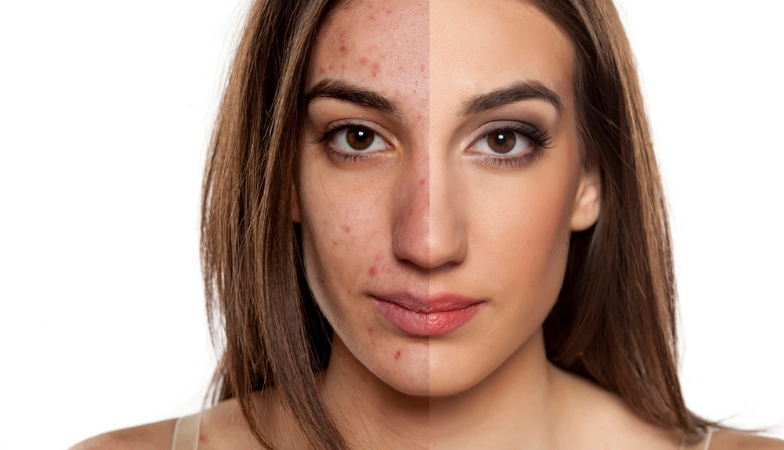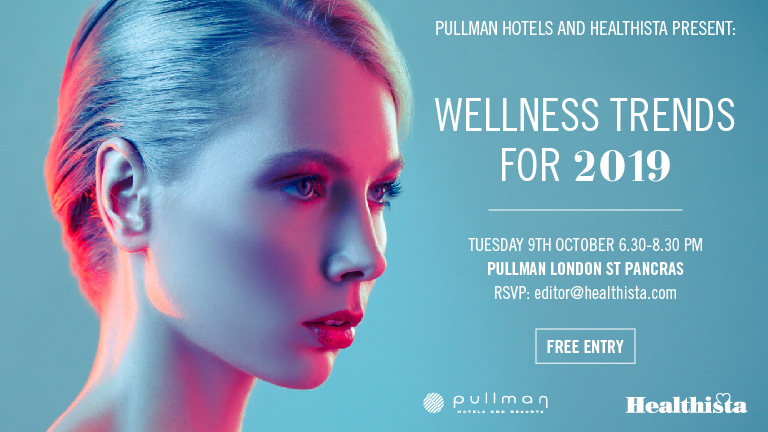Your body is constantly sending signs to the outside you about what’s going on inside. Here’s how to read your symptoms from mouth ulcers to eye twitches, nail ridges to pimples
Our bodies are on a never-ending mission to communicate with us on the outside, what’s going on on the inside. But sometimes these signs are too subtle or we don’t pay them enough attention until they become something more serious.
Here’s how to read some of the subtle health messages your body is trying to send you and become your own body whisperer.

1. Bloated tummy
Who hasn’t suffered from puffer-fish syndrome at some point in their lives? A staggering 70 per cent of us have reported suffering from regular bloating.
A bloated tummy is that uncomfortable sensation you get when your stomach feels stretched and puffy. In essence, this happens when your stomach is full – full of food, fluid or gas.
Your body is basically trying to tell you’re not digesting your food properly or that you have a food allergy or intolerance such as to wheat or lactose.
‘Other common causes of bloating include hormonal issues, candida, constipation, too much sugar or booze, stress, dysbiosis (an imbalance between the good and bad bacteria in our digestive tract) or IBS,’ says Rick Hay, Healthista’s Nutritional Director, a nutritionist and lecturer in weight management at The College of Naturopathic Medicine.
Consuming large meals, however healthy they may be, can themselves cause bloating from the sheer volume. Simply eating too much at once can also dilute down the acid in our stomach, rendering it unable to start breaking down the food efficiently.
Furthermore, enzymes that act optimally at a lower, more acidic pH, cannot function as well which means that food remains only partially digested and needs to be broken down further.
This is usually done by bacteria in the gut and the consequent fermentation process results in the release of gases that may also cause bloating.
Certain sugars from foods can also cause bloating. Called Fermentable Oligosaccharides, Disaccharides, Monosaccharides and Polyols or FODMAPs for short do this through the release of gases from fermentation. Food high in FODMAPS include broccoli, cauliflower, artificial sweteeners such as maltitol, sorbitol, xylitol as well as beans and pulses.
Various studies have shown that diets rich in FODMAPs are more likely to cause symptoms associated with IBS including bloating.
What helps?
‘The first thing to do if you are on a high FODMAP diet is to lower your intake. A 2010 study showed that simply going on a low FODMAP diet is an effective way to relieve the symptoms of functional gut issues’ suggests Hay.
The NHS also recommends probiotics to help rebalance your gut flora. A 2015 double-blind, placebo controlled clinical trial by the Department of Medicine’s Division of Gastroenterology at the University of North Carolina, in which 60 subjects suffering from bloating and other gut symptoms showed that two probiotic strains, namely Lactobacillus acidophilus NCFM (L-NCFM) and Bifidobacterium lactis Bi-07 (B-LBi07), can relieve gut symptoms such as bloating.
‘I also suggest digestive enzymes as these will assist in the breakdown of food before it gets to the gut thereby avoiding the need for further digestion and bacterial fermentation.
‘If you have pinpointed what makes you inflate like a balloon – lactose, for example – try having a digestive enzyme that will help break it down. In the case of lactose, take lactase’ explains Hay.
‘Fermented foods such as sauerkraut are also a good option as they start being broken down before they are actually consumed making them more easily digestible by our bodies. Furthermore, the friendly bacteria in fermented foods will also help rebalance your gut flora,’ explains Hay.
Always look for raw, live sauerkraut from the fridge in the health food store to ensure the bacteria in it is healthy and alive. We love everything from Lauries Foods.
Aloe vera juice is a good digestive system lubricant too as it helps food slip down the gastro intestinal tract (GIT) more easily thereby aiding gastric emptying.
‘Swedish bitters, which are a herbal formula that promote bile synthesis and release, are especially good for fat digestion’ explains Hay.
Get BioCare Probiotics (£7.75) and Fushi Organic Aloe vera juice (£10.99) from Healthista shop

2. Red inflamed skin and acne
If you feel like you are still at the height of puberty, this is the right place for you.
According to a 2013 review, the causes of skin inflammation and acne are many and will vary from person to person.
However, the most common causes are often hormone-related. The review explains that testosterone is the hormone that promotes acne the most so acne is a big issue for males and teenage boys in particular.
But women also tend to get acne flare ups about one week before their menstruation starts due to a dip in oestrogen levels which, funnily enough, prevent the development of acne.
Women with Polycystic Ovarian Syndrome (PCOS) tend to have an imbalance of testosterone and that’s why recurrent acne (along with weight gain around the middle and excess facial hair) is one of the leading symptoms of PCOS.
‘When you get acne, your body may also be trying to alert you to an underlying hormonal or digestive disturbance.
‘It could also be a result of liver imbalance, poor diet especially if you eat too much carbohydrate, stress and allergies amongst other things,’ explains Hay.
Red inflamed acne with a white discharge is usually indicative of excess carbohydrate consumption and bacterial overgrowth.
‘The pus is the result of your immune system trying to fend itself off the bacterial infection. During this battle, immune system cells sacrifice themselves to keep the infection at bay and the result is a white discharge or pimple.
‘The redness and local swelling itself are caused by pro-inflammatory chemicals released by the body that dilate local blood vessels so that more of these soldier cells, are recruited to the area to fight the incoming invaders’ explains Hay.
What helps?
‘Take bitter liver tonics like milk thistle or dandelion to help with liver function. I also recommend algal oil or fish oil to help reduce pro-inflammatory chemicals,’ suggests Hay. ‘The healthy omega fatty acids in these oils are anti-inflammatory so they will also help prevent inflammation.
‘Vitamins A, C and E are powerful antioxidants and therefore have anti-inflammatory effects too.
‘And if you are still looking for more help, grapeseed extract is a wonderful source of a class of phytochemicals with powerful anti-oxidative properties called polycyanidins’ explains Hay.
Get Lifeplan’s Milk Thistle (£4.99) and BioCare’s vegan omega 3 (£13.95) from Healthista’s shop
3. White coating on the tongue
A thin white coating on the tongue can be indicative of digestive disturbances such as microbiome imbalance, iron or B vitamin deficiency and possibly diabetes, asserts Hay.
‘In the case of iron and vitamin B deficiency it is quite likely you will be feeling constantly tired.’ Read more about the signs of iron deficiency here.
‘Thick, white spots on the tongue that look like pus are more likely to be oral thrush (a yeast infection), leukoplakia (white patches inside the mouth or on the tongue and gums especially common in smokers and those who use smokeless tobacco), or oral lichen planus (a non-infectious itchy white rash that can affect many parts of the body including the inside of the mouth).
‘In the case of lichen planus it is important to keep it monitored by a medical professional,’ explains Hay.
What helps?
‘Iron and B vitamins are essential if there is an underlying deficiency of these. Take some vitamin C with your iron supplement as it will help maximise iron absorption in the gut.
‘Remember to avoid drinking coffee or tea at the same time you have your iron supplements as these will inhibit iron absorption in the gut.
‘I also highly recommend a good probiotic and some digestive enzymes such as papain (from papaya) and bromelain (from pineapple) to give your digestive system a hand in breaking down your food.
‘If you are pre-diabetic or diabetic you may want to take some cinnamon and chromium but make sure you discuss with your doctor first. Chromium is particularly good for diabetics as it reduces insulin resistance’ explains Hay.
A 2014 study in China demonstrated that chromium picolinate, the main component of a traditional Chinese remedy called TianMaiXiaoKe, can modulate blood glucose levels and improve insulin resistance. In China, TMXK tablets are used to treat type 2 diabetes.
Buy Floradix’s liquid iron and vitamin formula (£10.95) from Healthista’s shop

4. Vertical and horizontal nail ridges
Healthy looking nails should be smooth, curved, with a shine to them and have no spots.
The thing about nails is that they can cause potentially serious self-image and self-esteem harm.
Nail ridges themselves are nothing to be overly concerned about as far as physical health goes but if untreated, they can pose a social problem.
‘That is not to say, however, that you shouldn’t have them checked out by your GP just to be on the safe side,’ suggests Hay.
Vertical ridges: ‘Vertical nail ridges are usually nothing to be worried about. Dry skin, calcium, zinc, iron, biotin, vitamin A and protein deficiency can all cause ridges on the nails that run from the tip of the nail to the cuticle. Even ageing can cause nail ridging’ explains Hay.
Repeated wetting and drying of the hands and over-painting your nails (especially that Shellac addiction you’ve been nursing for years) can also lead to accentuated vertical nail ridging and splitting and is in fact the single most common cause of nail ridging.
Horizontal ridges: Horizontal ridges don’t automatically signify a serious condition but if you have them, it is probably a good idea to get yourself checked by your GP. They usually reflect a retrospective physiological condition and a slow down of the nail matrix activity.
Rick Hay explains that ‘according to the NHS, diabetes, kidney, an over or underactive thyroid and inflammation, can all cause this type of ridging.
‘In more serious instances, it can be indicative of heart, lung or liver problems. But don’t panic, the more serious causes are quite rare and you shouldn’t worry yourself about something that, more often than not, will turn out to be nothing major’
What helps?
‘If you constantly paint your nails, the first thing I would suggest is to give them a break.
‘Also, wear gloves if you are constantly running around the house collecting and washing the kid’s dirty dishes. Or better yet, get them to do it for a little extra pocket money.
‘I also recommend a good multi-vitamin and mineral that supports good general nail health. It should include biotin, zinc, iron and calcium’ suggests Hay. We love Alive! Women’s Daily Max Potency Multivitamin.
‘Horsetail is rich in silica which has been traditionally used to promote healthy hair, skin and nails
‘A balanced diet high in vitamins, minerals and plant-basd protein may help prevent nail ridges so make sure your diet includes whole grains, fresh fruit and vegetables and healthy nuts and seeds
Get Healthista’s berry flavoured vegan Lean Protein powder (£24.99) from Healthista’s shop.
5. Cold sores and mouth ulcers
‘OK, let’s get our facts straight first, cold sores and mouth ulcers are not the same thing,’ says Hay.
‘For starters, mouth ulcers are found on the inside of the mouth on the gums, tongue and inner cheeks whereas cold sores develop on the outside on the lips’ explains Rick Hay.
‘Most importantly, whilst mouth ulcers are indicative of a weakening immune system, they are non-contagious.
‘Cold sores on the other hand are a manifestation of a dormant viral infection which flares up whenever our immune system becomes compromised for whatever reason.
‘The take home message here is that mouth ulcers and cold sores are a red alert for a compromised immune system. Your body is telling, or rather showing you that your immune systems is in need of some TLC.
‘They often start popping up as the weather gets colder and in times of stress both of which can weaken our body’s innate protective systems’ says Hay.
What helps?
‘To target the immune system directly, have some Manuka honey and increase your vitamin C intake.
‘A 2014 review of the composition and biological activity of Manuka honey reported on the proven antioxidant, anti-inflammatory and anti-microbial action of Manuka honey.
Olive leaf extract can be taken for extra support because of its antioxidative and anti-inflammatory properties
‘Echinacea, especially in tincture form, is also a great immune booster. You can take a small dose long-term or you can take a bigger dose just when you feel there’s something stirring up. Don’t wait for the cold sores to fully break out before you start taking it,’ suggests Hay.
A 2015 study reported that echinacea especially targets and activates a class of immune cells called neutrophils as well as other white blood cells but to a lesser degree.
Neutrophils are your body’s first line of defense, your innate immunity, and they become activated against foreign intruders before you even start noticing the symptoms of whatever is attacking you.
Rick Hay explains further: ‘to address stress, the key is to target the nervous system and the adrenal glands, the source of our stress hormones.
‘B Vitamins and nervines, which are herbs that act as nerve tonics such as lemon balm and the humble chamomile, will give your nervous system the helping hand it needs.
‘To relieve stress further, consider adaptogenic herbs such as Ashwagandha, St John’s Wort, rhodiola and gotu kola.
‘To improve digestive function, try apple cider vinegar to help with stomach acid levels.
‘Lysine is an amino acid that many people take to help shorten the duration and severity of cold sores however research is still needed to fully support this claim,’ Hay asserts.
Buy Vogel’s Echinacea (£10.40) and Lifeplan’s Manuka honey (£7.99) and Pukka Wholistic Ashwagandha £16.95 from Healthista’s shop.

6. Yellowing of the eyes and/or skin
‘It is important to distinguish the significance of yellowing of the eyes versus yellowing of the skin,’ says Hay.
Whereas yellowing of the skin may be attributed to an excess intake of beta carotene, vitamin A and vitamin C, in which case it usually poses no threat, yellowing of the eyes is usually observed in people whose livers may be in trouble,’ explains Rick Hay.
‘In this case, seek medical advice as soon as possible, the earlier the problem is diagnosed, the better the prognosis.
‘Jaundice, the yellow discolouration itself, occurs when a compound called bilirubin builds up in the body. The yellowing of the skin and/or eyes can be symptomatic of something more serious but they are all fundamentally either directly or indirectly related to the health status of the liver.’
According to the NHS, jaundice can be caused by gallstones, alcoholic liver disease, pancreatitis, hepatitis, sickle cell, amongst others.
The precise treatment for jaundice will depend on the underlying cause itself.
Gallstones for example are usually formed when there are unusually high levels of cholesterol or bilirubin inside the gall bladder. However, there are simple steps you can take to help prevent the extra burden on your liver.
What helps?
Needless to say, cut down on your favourite alcoholic tipple. Also, avoiding fatty foods is an easy but important step to take not to overload your liver.
‘Fish or Algal oil are useful as these contain healthy omega fatty acids.
‘Milk Thistle is my go-to herb for any kind of liver problem,’ Hay suggests. Amongst its many health-promoting phytochemicals is a compound called silymarin.
Silymarin has been thoroughly researched has shown to have liver-protecting properties due to its ability to enhance glutathione, one of the most powerful naturally occurring antioxidants.
‘Dandelion is another go-to herb I would highly recommend. It too is a member of the class of bitter herbs which means it will do wonders for the liver.
‘Dandelion, like many of its bitter partners, promotes bile secretion which will aid digestion in general and especially of fats and oils’ explains Hay.
Get Pharma Nord’s fish oil (£7.95) from Healthista’s shop and Lifeplan’s Milk Thistle (£4.99) from Healthista’s shop.
7. Eye twitches
If your eyes keep on twitching every now again out of nowhere, your body is trying to tell you that your nervous system is not very happy.
But don’t panic, eye twitches are rarely a sign of anything to be concerned about and more often than not will stop by themselves.
‘Electrolyte imbalance and the hydration status of your body are quite often the culprits of nerve spasms and these can be easily fixed’ explains Hay.
Eye twitches can also signify a magnesium deficiency.
A recent article published in June this year on the scientific journal Nutrients by the American University of Washington reported that ‘from a neurological standpoint, magnesium plays an essential role in nerve transmission and neuromuscular conduction.’
Magnesium is essential to nerve signal function, which is why lacking it could be causing your eye twitches.
What helps?
‘Common causes of eye twitches are electrolyte and vitamin deficiencies especially of magnesium and B vitamins.
‘Caffeine and alcohol are nervous system stimulants so if your muscles frequently cramp and spasm, it would probably be a good idea to cut down on them,’ says Rick Hay.
‘Eye twitches may also be a side effect of a variety of medications out there. Usually these disappear naturally and don’t require any intervention to resolve but if your muscle spasms last longer than two weeks and/or are happening in more than one area it’s probably best to see your GP just to be on the safe side.
‘If everything is in order, try increasing your magnesium intake.
‘The importance of magnesium for the nervous system is well known and there are various studies supporting its beneficial effects,’ explains Hay.
Buy BetterYou’s magnesium foot soak (£3.49) from Healthista’s shop
More related Healthista content
8 signs of iron deficiency even doctors miss
8 signs you have coeliac disease that might surprise you
6 signs stress is affecting your fertility


